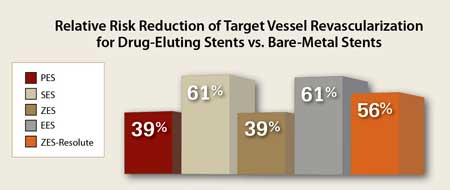Benefits of DES vs. BMS Sustained Long Term
Drug-eluting stents have been shown to be efficacious in reducing the risk for target vessel revascularization and target lesion revascularization over the long and short term when compared with bare-metal stents in a study with more than 100,000 patient-years of follow-up.
The meta-analysis included 77 randomized clinical trials that enrolled 57,138 patients and included 117,762 patient-years of follow-up (mean follow-up, 2.1 years). Researchers identified six stent types for the purpose of analysis: BMS; sirolimus-eluting stents (SES); paclitaxel-eluting stents (PES); everolimus-eluting stents (EES); zotarolimus-eluting stents (ZES); and ZES-Resolute.
Overall, DES led to reductions in long-term (>1 year) TVR (range, 39%-61%) vs. BMS, although this varied depending on stent type (see graphic). All DES led to reductions in MI (with the exception of PES), while EES also led to reductions in stent thrombosis compared with BMS. There was no increase in the risk of long-term safety outcomes — death, MI or stent thrombosis — with any DES vs. BMS. Researchers also reported that there was a more than 42% probability that EES had the lowest TVR, and that the safest stent appeared to be the EES with a more than 86% probability.

Short-term outcomes were found to be similar to long-term outcomes.
“This comprehensive analysis of currently FDA-approved stents provides providers and patients with a scorecard on the relative efficacy and safety of stents,” said Sripal Bangalore, MD, MHA, director of research, cardiac catheterization laboratory, New York University School of Medicine. “Of the currently used stents, EES and ZES-R are the most efficacious in reducing the risk of restenosis and EES is the safest stent in reducing the risk of stent thrombosis, even better than BMS. It therefore dispels the popular notion that BMS are the benchmark for safety, and changes the paradigm for comparator arms for future newer stent trial designs.”
For more information:
Bangalore S. Circulation. 2012;125:2873-2891.
Disclosure: Dr. Bangalore reports no relevant financial disclosures.
